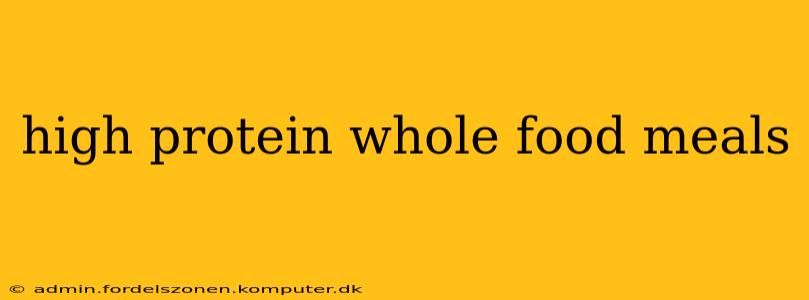Are you looking to increase your protein intake while sticking to a whole-foods diet? You're not alone! Many people are seeking healthier, more sustainable ways to boost their protein levels, and focusing on whole foods is a fantastic approach. This guide will explore delicious and nutritious high-protein whole food meals, helping you build muscle, maintain energy, and support overall well-being. We'll delve into practical meal ideas, address common concerns, and provide tips for making these meals a regular part of your diet.
What are Whole Foods?
Before we dive into specific meal plans, let's define what constitutes a "whole food." Essentially, whole foods are minimally processed ingredients that retain their natural nutrients. Think fresh fruits and vegetables, whole grains, legumes, nuts, seeds, and lean protein sources like fish, poultry, and eggs. Avoiding processed foods, added sugars, and excessive unhealthy fats is key to a successful whole-foods diet.
High-Protein Whole Food Meal Ideas:
Here are some examples of satisfying and nutritious high-protein whole food meals, categorized for easy browsing:
Breakfast:
- Greek Yogurt with Berries and Nuts: Greek yogurt is a protein powerhouse. Combine it with your favorite berries for antioxidants and a handful of almonds or walnuts for healthy fats and extra protein.
- Oatmeal with Protein Powder and Fruit: Boost your oatmeal's protein content by adding a scoop of whey or plant-based protein powder. Top it with sliced bananas or berries for sweetness and extra nutrients. Choose a protein powder with minimal added ingredients.
- Scrambled Eggs with Spinach and Whole-Wheat Toast: Eggs are an excellent source of protein and essential amino acids. Add spinach for added vitamins and minerals, and serve with a slice of whole-wheat toast for sustained energy.
Lunch:
- Lentil Soup with a Side Salad: Lentils are packed with protein and fiber. A hearty lentil soup is a satisfying and nutritious lunch option. Pair it with a side salad for extra vitamins and minerals.
- Chicken Salad Sandwich on Whole-Wheat Bread: Use grilled chicken breast and mix it with avocado, chopped celery, and a touch of mustard instead of mayonnaise. Serve on whole-wheat bread for a protein-rich and satisfying lunch.
- Quinoa Salad with Chickpeas, Feta, and Vegetables: Quinoa is a complete protein, meaning it contains all nine essential amino acids. Combine it with chickpeas, feta cheese (for a boost of protein and flavor!), and your favorite vegetables for a vibrant and filling lunch.
Dinner:
- Baked Salmon with Roasted Vegetables: Salmon is rich in protein and omega-3 fatty acids. Roast it alongside your favorite vegetables like broccoli, asparagus, or sweet potatoes for a complete and balanced meal.
- Chicken Stir-fry with Brown Rice: Use lean chicken breast and load up on colorful vegetables like bell peppers, broccoli, and carrots. Serve over brown rice for added fiber and complex carbohydrates.
- Lentil Shepherd's Pie with Sweet Potato Topping: A hearty and healthy twist on a classic comfort food. Lentils provide the protein base, and a sweet potato topping offers a naturally sweet and nutritious alternative to mashed potatoes.
How Much Protein Do I Need?
H2: How Much Protein Do I Need?
The recommended daily protein intake varies depending on factors like age, activity level, and overall health goals. Consult a healthcare professional or registered dietitian to determine your individual needs. General guidelines suggest consuming 0.8 grams of protein per kilogram of body weight for maintaining a healthy adult diet, with increased amounts needed for athletes or individuals with specific health goals.
What are the Benefits of High-Protein Whole Food Meals?
H2: What are the Benefits of High-Protein Whole Food Meals?
Consuming high-protein whole food meals offers a multitude of benefits:
- Increased Satiety: Protein keeps you feeling fuller for longer, aiding in weight management and reducing cravings.
- Muscle Growth and Repair: Protein is essential for building and repairing muscle tissue, crucial for both athletes and individuals seeking to maintain muscle mass as they age.
- Improved Metabolism: Protein boosts metabolism, helping your body burn more calories throughout the day.
- Enhanced Energy Levels: Sustained protein intake provides consistent energy, preventing energy crashes often associated with carbohydrate-heavy diets.
- Stronger Bones and Immune System: Protein plays a vital role in bone health and immune function.
Are There Any Downsides to High-Protein Diets?
H2: Are There Any Downsides to High-Protein Diets?
While generally safe, excessively high-protein diets can have potential downsides:
- Kidney Strain: Individuals with pre-existing kidney conditions should exercise caution and consult their doctor before significantly increasing protein intake.
- Dehydration: Protein metabolism requires adequate water intake. Ensure you drink plenty of water throughout the day.
- Nutrient Imbalances: Focusing solely on protein can lead to deficiencies in other essential nutrients if not balanced with a variety of whole foods.
By following the guidelines above and incorporating these delicious and nutritious meal ideas, you can successfully increase your protein intake while enjoying the wholesome goodness of whole foods. Remember to listen to your body and adjust your intake based on your individual needs and preferences. Consulting with a healthcare professional or registered dietitian can provide personalized guidance for optimal health and well-being.
